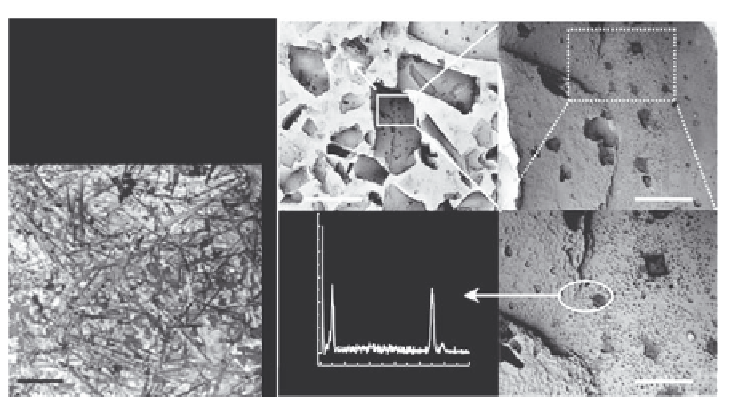Geoscience Reference
In-Depth Information
(b)
Activated carbon
Activated carbon
grain
Activated carbon
grain
grain
(a)
10
10
μ
μ
m
m
2
μ
m
C
250
200
150
100
50
0
O
Ti
1
μ
m
0
100 200 300 400 500 600
(×1/100)
Energy (ev)
20
μ
m
Figure 10.75 (a) ZnO:CNT and (b) TiO
2
:activated carbon
[19,339]
.
by 50
80 mesh. First activated carbon was washed with double distilled water
until the black color of washings disappeared, followed by soaking in 5% HCl solu-
tion with constant shaking for 24 h. Further, it was washed with distilled water till
the pH of washings became neutral. Finally, the product was dried at about 80
C.
Then a required amount of activated carbon (2 g) was taken in a Teflon liner con-
taining a desired amount (10 ml) of different molar concentrations of HNO
3
and
NaOH as solvents. The active metal oxides such as TiO
2
and ZnO were taken in
the form of respective oxides or gels. This mixture was stirred well using a mag-
netic stirrer for 2 h. Later, the Teflon liner was placed in an autoclave, which was
kept inside a furnace provided with a temperature programmer controller. The tem-
perature of the furnace was raised slowly up to a predetermined temperature
(150
200
C) for a period of 8
24 h. A.C:ZnO shows better catalytic properties
than A.C:TiO
2
.
Figure 10.75
shows the ZnO:CNT and TiO
2
:A.C composites
[19,339]
. However, the greatest disadvantage of these composites is the high cost
of activated carbon, but definitely, activated carbon:metal oxide
based composites
have been proven to be better photocatalysts than the pure metal oxides.
Recently, the authors
[338]
have reported the hydrothermal preparation of
Nd
2
O
3
-coated titania composite particles for photocatalytic applications. They
used 1 M NaOH at 250
Candpressure
80 bar with an experimental duration of
B
5
72 h. A different wt% of Nd
2
O
3
wasusedforthecoatinginordertorevealthe
role of Nd
2
O
3
. Highly monodispersed nanocomposite particles were obtained.
Figure 10.76
shows the schematic representation of the formation of Nd
2
O
3
-
coated titania designer composite particulates. Similarly, there are several reports
on the hydrothermal coating of functional materials on some ceramic supports.
For example, ZnO and TiO
2
nanoparticulates are coated on calcium aluminum sil-
icate beads as supports under hydrothermal conditions (
Figure 10.77
)with1M

